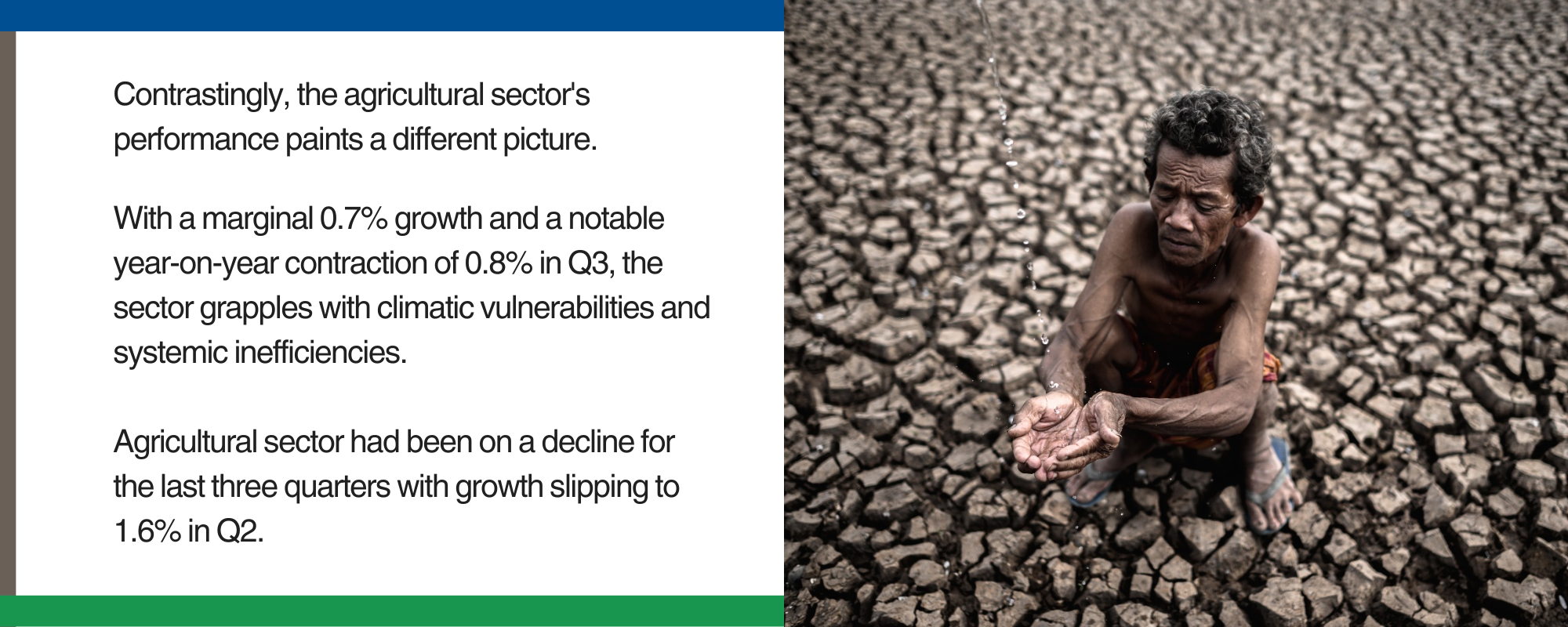India’s economy has once again defied global slowdown with the GDP for the third quarter of the fiscal year 2024 (Q3 FY24) soaring to 8.4%, its highest in the last six quarters. This growth, significantly driven by the manufacturing and construction sectors, signals a robust recovery trajectory and shows the economy’s resilience amid high inflation across the globe and escalating geopolitical tensions.
However, a granular analysis reveals a complex landscape marked by sectoral disparities. Agriculture is showing a muted performance, and is facing challenges in stimulating consumption demand, while a deep-dive into the GVA figures needs a more nuanced explanation of the underlying economic dynamics.
Manufacturing and Construction: Pillars of Growth
At the top of economic expansion are manufacturing and construction sectors. Manufacturing, with an 11.6% year-on-year growth, and construction, expanding by 9.5%, have capitalised on the government’s sustained focus on capital expenditure. Further, supportive government policies and lower input costs aiding the GDP growth numbers.
These sectors have demonstrated industrial robustness and underscored the economy’s infrastructural development ambitions. The performance shows that the government’s focus of concentrating on infrastructure growth is paying off, and ultimately will benefit all sections of the economy, including long-term economic growth.
Agricultural Sector: Facing Headwinds

These challenges reflect deeper issues within the agrarian economy, including dependency on monsoon rains and the need for enhanced productivity measures. Despite governmental efforts through capital expenditure and policy initiatives aimed at stimulating growth, challenges in reviving private consumption expenditure persist. The slight improvement from 2.4% year-on-year growth in the previous quarter to 3.5% remains below the pre-pandemic average.
This recovery, although modest, points to the ongoing challenges in rural demand, further exacerbated by inflationary pressures and the impact of inadequate monsoon rains. The sector’s struggles not only impact rural livelihoods but also pose broader economic implications, which will need the targeted interventions and policy reforms.
The GDP and GVA Divergence: Unpacking Economic Health
The disparity between GDP and Gross Value Added (GVA) growth rates during this period is also quite high. While GDP growth, inclusive of net taxes, reached 8.4%, GVA growth stood at 6.5%. This gap, primarily attributed to a 32% real-term increase in net taxes, highlights the influence of fiscal strategies on GDP figures.
However, a sector-specific evaluation to understand the true performance of the economy beyond the buoyancy provided by tax-related adjustments is imminent . Overall, the GVA figure, in this context, has seen a decline over Q2 from 7.7% to 6.5%, so there has been a marginal slowdown in the GVA. Also, note that this is for the third consecutive quarter that GVA has decline. Some sectors like construction, hotels and transport, and finance, real estate and professional services have done well sequentially posting a decent growth.
Strengthening foundations: Rising investments
In terms of the broader economic landscape, there were some shifts in the domain of domestic savings and investment rates. In 3QFY24, domestic savings increased to an impressive 29.1% of GDP, up from 26.9% in 3QFY23. This reflects a positive trend in the financial behaviour of households and businesses.
Concurrently, India’s investment rate experienced a significant rise too, jumping to 31.9% of GDP in 3QFY24, compared to 30.7% in the same quarter of the previous year. This increase in investment also shows enhanced confidence in the country’s growth prospects and the efficacy of policy measures aimed at stimulating economic activity.
Moreover, a reduction in net imports to 2.8% of GDP from 3.9% further accentuates the positive shift in India’s economic parameters. A favourable trade balance has a fair share of its contributory effect on domestic savings.
India’s Economy: Against global Slowdown Concerns
As the global economy grapples with slowdown fears, India’s economic performance for FY24 is resilient, to say the least. The undercurrent of weaker private consumption growth casts a shadow of concern. There are potential vulnerabilities in the economic fabric that may impede sustained growth momentum. Further, global economic growth is muting with Europe, particularly Germany showing signs of a recession.
Also, the January’s core sector performance reveals a nuanced picture with growth decelerating to a 15-month low of 3.6%, a dip from December’s 4.9%. This slowdown is attributed to marked contractions in the petroleum refinery and fertiliser sectors, which recorded declines of 4.4% and 0.6%, respectively. The Index of Industrial Production (IIP) growth may remain modest due to these factors. Hence, for the final quarter of FY24, GDP growth is expected to moderate to approximately 6%.
Nevertheless, India’s economic narrative as we close FY24 is of cautious optimism. Despite facing some tough global headwinds, and with oil prices rising, the economy demonstrates areas of robust growth. The outlook leans towards a sustained, albeit moderated, growth trajectory.
Looking ahead, the real GDP growth for FY24 is pegged at a robust 7.6%, which may surpass initial estimates. This growth has come from the strong first half, and is expected to largely driven by strong investments and the dynamism of the industrial, and core infrastructure, including services sectors.
Looking further into the horizon, for FY25 we may see a moderation in growth momentum, with real GDP growth anticipated to decelerate to between 5.5-6%. This dip is on expected lines as the global headwinds amid inflationary pressures remain persistent. India’s GDP may pick up beyond the monsoon quarter of FY25, as global inflationary pressures ease and the US Fed expected claws back on high interest rates.
The overarching narrative of India’s economic resilience and potential for sustained growth remains intact, though, buoyed by domestic infra and parts of the domestic consumer sector.